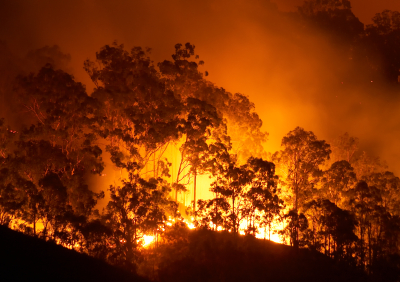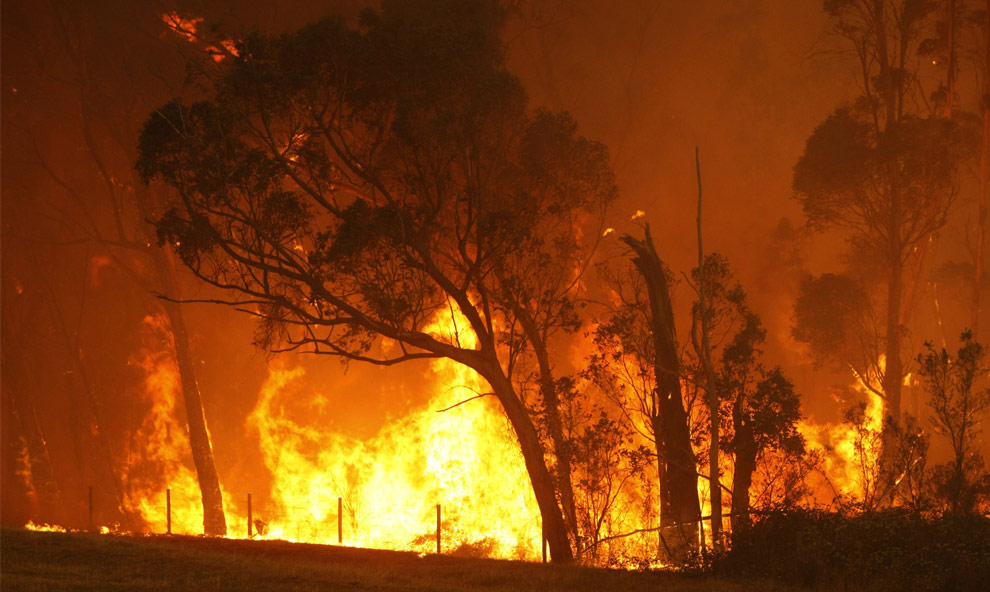Source google.com.pk
Australian Wildfires
Temperatures across southern Australia have dropped from record levels, reducing the danger from scores of bushfires but likely to bring only a brief respite from the summer's extreme heat.
No deaths have been reported from the bushfires in the south-east of the country, although about 100 people have not been accounted for since last week when a fire destroyed around 90 homes in the Tasmanian town of Dunalley, east of the state capital Hobart.
On Wednesday, police spokeswoman Lisa Stingel said it was likely most of those unaccounted for simply have not checked in with officials.
"There are no reports of missing persons in circumstances that cause us to have grave fears for their safety at this time," Tasmania police acting commissioner Scott Tilyard said.
Thousands of cattle and sheep are suspected to have been killed, as well as a great deal of wildlife.
In Victoria state, north of Tasmania, a fire injured six people, destroyed four homes and caused the evacuation of the farming community of Carngham, Country Fire Authority operations officer Ian Morley said.
Cooler conditions on Wednesday brought relief to firefighters who had been working through the day to build earth breaks to contain the fire ahead of warmer temperatures forecast for Friday, he said. "We have had very mild, cool conditions overnight, which is a great help to the fire suppression effort," he added.
North of Victoria in New South Wales, Australia's most populous state, firefighters were battling 141 fires, including 31 that had not yet been contained.
Fires have burnt through more than 131,000 hectares (324,000 acres) of forest and farmland since Tuesday.
Fires burning out of control near the towns of Cooma, Yass and Shoalhaven were causing the most concern in that state.
Deputy Commissioner Rob Rogers of the Rural Fire Service said the reprieve was expected to be short-lived, with temperatures forecast to climb again by the end of the week. "We don't need new fires today," he said.
The fires have been most devastating in Tasmania, where at least 128 homes have been destroyed since Friday. Hundreds of people remain at two evacuation centres in the south of the state.
"People have lost everything. We can't comprehend that devastation unless we are in their shoes," said the Tasmanian premier, Lara Giddings.
The fires have consumed over 80,000 hectares (198,000 acres) in Tasmania since last week.
Wildfires are common during the Australian summer. Fires in February 2009 killed 173 people and destroyed more than 2,000 homes in Victoria.
Australia had its hottest day on record on Monday and the country's weather bureau has forecast above average temperatures for the remainder of the summer, compounding the fire risk created by a lack of rain across central and southern Australia over the past six months.
A wildfire is an uncontrolled fire in an area of combustible vegetation that occurs in the countryside or a wilderness area. Other names such as brush fire, bushfire, forest fire, desert fire, grass fire, hill fire, peat fire, vegetation fire, and veldfire may be used to describe the same phenomenon depending on the type of vegetation being burned. A wildfire differs from other fires by its extensive size, the speed at which it can spread out from its original source, its potential to change direction unexpectedly, and its ability to jump gaps such as roads, rivers and fire breaks. Wildfires are characterized in terms of the cause of ignition, their physical properties such as speed of propagation, the combustible material present, and the effect of weather on the fire.
Wildfires are a common occurrence in Australia especially during the long hot summers usually experienced in the southern regions such as Victoria, Australia. Due to Australia's hot and dry climate, wildfires (commonly referred to as bushfires in Australia) pose a great risk to life and infrastructure during all times of the year, though mostly throughout the hotter months of summer and spring. In the United States, there are typically between 60,000 and 80,000 wildfires that occur each year, burning 3 million to 10 million acres of land depending on the year. Fossil records and human history contain accounts of wildfires, as wildfires can occur in periodic intervals. Wildfires can cause extensive damage, both to property and human life, but they also have various beneficial effects on wilderness areas. Some plant species depend on the effects of fire for growth and reproduction, although large wildfires may also have negative ecological effects.
Strategies of wildfire prevention, detection, and suppression have varied over the years, and international wildfire management experts encourage further development of technology and research. One of the more controversial techniques is controlled burning: permitting or even igniting smaller fires to minimize the amount of flammable material available for a potential wildfire. While some wildfires burn in remote forested regions, they can cause extensive destruction of homes and other property located in the wildland-urban interface: a zone of transition between developed areas and undeveloped wilderness.





Australian Wildfires
Temperatures across southern Australia have dropped from record levels, reducing the danger from scores of bushfires but likely to bring only a brief respite from the summer's extreme heat.
No deaths have been reported from the bushfires in the south-east of the country, although about 100 people have not been accounted for since last week when a fire destroyed around 90 homes in the Tasmanian town of Dunalley, east of the state capital Hobart.
On Wednesday, police spokeswoman Lisa Stingel said it was likely most of those unaccounted for simply have not checked in with officials.
"There are no reports of missing persons in circumstances that cause us to have grave fears for their safety at this time," Tasmania police acting commissioner Scott Tilyard said.
Thousands of cattle and sheep are suspected to have been killed, as well as a great deal of wildlife.
In Victoria state, north of Tasmania, a fire injured six people, destroyed four homes and caused the evacuation of the farming community of Carngham, Country Fire Authority operations officer Ian Morley said.
Cooler conditions on Wednesday brought relief to firefighters who had been working through the day to build earth breaks to contain the fire ahead of warmer temperatures forecast for Friday, he said. "We have had very mild, cool conditions overnight, which is a great help to the fire suppression effort," he added.
North of Victoria in New South Wales, Australia's most populous state, firefighters were battling 141 fires, including 31 that had not yet been contained.
Fires have burnt through more than 131,000 hectares (324,000 acres) of forest and farmland since Tuesday.
Fires burning out of control near the towns of Cooma, Yass and Shoalhaven were causing the most concern in that state.
Deputy Commissioner Rob Rogers of the Rural Fire Service said the reprieve was expected to be short-lived, with temperatures forecast to climb again by the end of the week. "We don't need new fires today," he said.
The fires have been most devastating in Tasmania, where at least 128 homes have been destroyed since Friday. Hundreds of people remain at two evacuation centres in the south of the state.
"People have lost everything. We can't comprehend that devastation unless we are in their shoes," said the Tasmanian premier, Lara Giddings.
The fires have consumed over 80,000 hectares (198,000 acres) in Tasmania since last week.
Wildfires are common during the Australian summer. Fires in February 2009 killed 173 people and destroyed more than 2,000 homes in Victoria.
Australia had its hottest day on record on Monday and the country's weather bureau has forecast above average temperatures for the remainder of the summer, compounding the fire risk created by a lack of rain across central and southern Australia over the past six months.
A wildfire is an uncontrolled fire in an area of combustible vegetation that occurs in the countryside or a wilderness area. Other names such as brush fire, bushfire, forest fire, desert fire, grass fire, hill fire, peat fire, vegetation fire, and veldfire may be used to describe the same phenomenon depending on the type of vegetation being burned. A wildfire differs from other fires by its extensive size, the speed at which it can spread out from its original source, its potential to change direction unexpectedly, and its ability to jump gaps such as roads, rivers and fire breaks. Wildfires are characterized in terms of the cause of ignition, their physical properties such as speed of propagation, the combustible material present, and the effect of weather on the fire.
Wildfires are a common occurrence in Australia especially during the long hot summers usually experienced in the southern regions such as Victoria, Australia. Due to Australia's hot and dry climate, wildfires (commonly referred to as bushfires in Australia) pose a great risk to life and infrastructure during all times of the year, though mostly throughout the hotter months of summer and spring. In the United States, there are typically between 60,000 and 80,000 wildfires that occur each year, burning 3 million to 10 million acres of land depending on the year. Fossil records and human history contain accounts of wildfires, as wildfires can occur in periodic intervals. Wildfires can cause extensive damage, both to property and human life, but they also have various beneficial effects on wilderness areas. Some plant species depend on the effects of fire for growth and reproduction, although large wildfires may also have negative ecological effects.
Strategies of wildfire prevention, detection, and suppression have varied over the years, and international wildfire management experts encourage further development of technology and research. One of the more controversial techniques is controlled burning: permitting or even igniting smaller fires to minimize the amount of flammable material available for a potential wildfire. While some wildfires burn in remote forested regions, they can cause extensive destruction of homes and other property located in the wildland-urban interface: a zone of transition between developed areas and undeveloped wilderness.
Australian wildfires

Australian wildfires

Australian wildfires

Australian wildfires

Australian wildfires

Australian wildfires

No comments:
Post a Comment